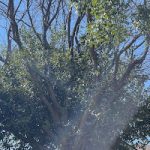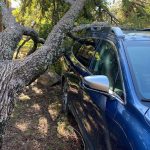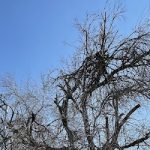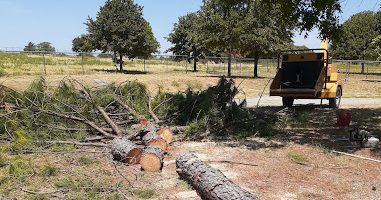
Tree removal permit requirements for homeowners in Denton, Texas and the DFW
July 9, 2025
If you’ve got a tree in your yard that’s leaning, dying, or just getting in the way, your first thought might be to cut it down. That’s totally understandable. But here in Denton, we’ve got some rules in place that catch a lot of folks off guard. And if you don’t follow the process, you could be looking at city fines or even a required replant.
We’ve worked with enough Denton homeowners to know where people get tripped up. Here’s a clear look at how the city handles tree removal permits and how to keep your project moving forward without any surprises.
What Is a Tree Removal Permit?
In Denton, a tree removal permit is the city’s way of protecting our most valuable trees. They want to make sure large, native, or heritage species-like live oaks and pecans-aren’t being removed without a solid reason. Permits help keep track of canopy loss and encourage responsible tree care across neighborhoods. If the tree is a certain size or type, you’ll likely need to file paperwork before touching it.
Why Permits Matter in Denton
These rules apply whether you’re in a newer subdivision or an older neighborhood. They’re not just for big developers.
- Even an unhealthy-looking tree might still need approval.
- Native trees like red oaks and elms are protected across most areas.
- Trunks measuring over 19 inches at about chest height usually trigger permit review.
We’ve seen many jobs hit roadblocks because no one checked with the city first. Trust us-it’s easier to ask now than fix it later.
Common Mistakes We See
Estimating Size by Sight
A quick glance can be misleading. The city measures tree diameter at 4.5 feet from the base. If you’re even slightly off, you could run into problems.
Assuming Dead Means Free to Remove
Just because a tree looks gone doesn’t mean the city won’t want a second opinion. Especially if it’s near walkways or other properties.
Forgetting the HOA Rules
Some neighborhoods in Denton-like those near Robinson Oaks or Forrestridge-have their own rules. The city might say yes, but your HOA might not.
Thinking the Tree Crew Handles Permits
We’ve had clients assume their tree service filed the permit, only to find out it never happened. Always clarify who’s handling the paperwork.
To be safe: Call Denton Planning or check with an arborist who deals with city rules every week.
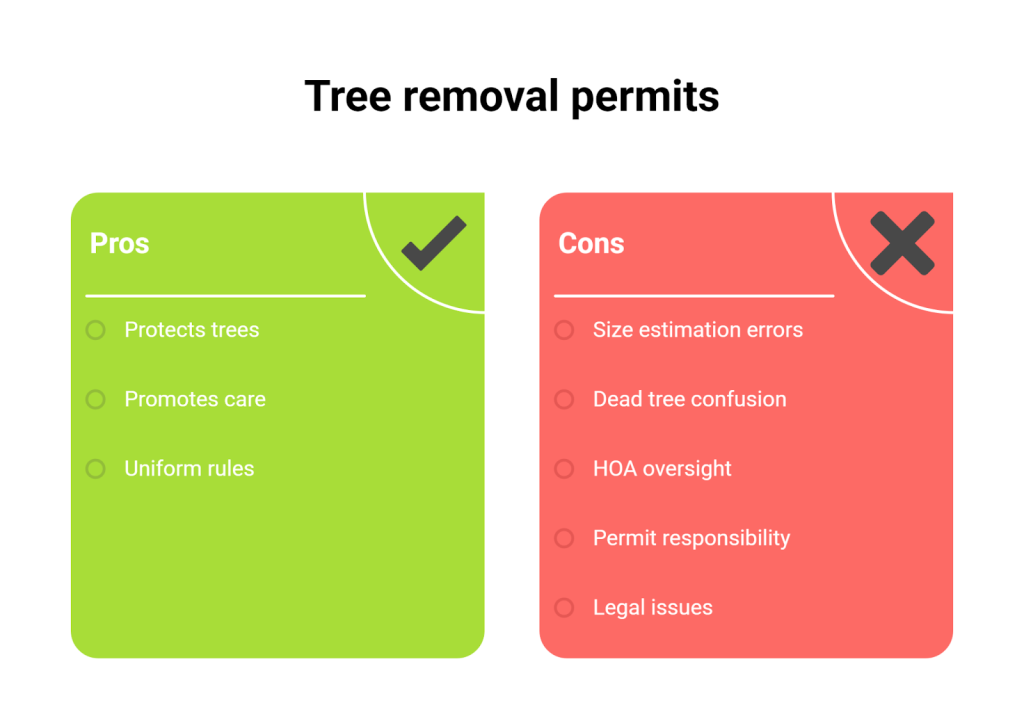
How the Permit Process Works
Step 1: Know What You’re Dealing With
Find out the tree species, measure the diameter at 4.5 feet high, and make note of where it sits on your property.
Step 2: Review the City’s Guidelines
Denton has a clear list of protected species and size thresholds. Check online or call their office to confirm.
Step 3: Submit Your Application
Most permit requests include a couple of photos, a basic site sketch, and a reason for the removal. If it’s tied to a building project, include those plans too.
Step 4: Wait for Approval
Usually, you’ll hear back in a few days. More complicated cases might take longer, especially if they need a site inspection.
Tip: Keep copies of everything you send and receive, just in case something comes up later.
When You Don’t Need a Permit
Sometimes you’re in the clear. No permit is usually required if:
- The tree is below the protected size threshold.
- It’s a non-native or invasive species.
- It poses an immediate danger (still smart to take photos before and after).
Even so, a quick call never hurts. We always tell clients-it’s easier to double-check than deal with city corrections.
Legal and Boundary Concerns
If you remove a protected tree without going through the proper steps, here’s what could happen:
- You may need to replant a new tree of equal size or type.
- The city could issue a fine or require a formal restoration.
- Follow-up site visits might be required.
And if your tree straddles a property line? You’ll definitely want to sort that out before taking action. Property surveys help avoid neighbor disputes.
What Folks Often Miss
Here are a few details we’ve seen overlooked:
- Lot lines: If you’re even close to the edge, pull out the survey.
- Buried lines: Always call 811 before digging out roots or stumps.
- Replanting rules: Some removals require you to plant a new tree or donate to a tree fund.
Tree Removal vs. Trimming in Denton
| Task | Permit Needed? | Description |
| Tree Trimming | Usually not | Light shaping or removal of small limbs |
| Structural Pruning | Rarely | Targeted removal for tree health/safety |
| Full Tree Removal | Often yes | Taking out the entire tree |
| Stump Grinding | No | Clearing remaining roots or stumps |
If it’s more than light pruning, ask first.
Talking to the City: Best Practices
Want things to go smoothly? Here’s what helps:
- Be clear about why the tree needs to come down.
- Include clear photos and any supporting documents.
- Respect their process and timelines. A little patience helps a lot.
Most of the time, city staff are willing to work with you if you keep communication clear.
After the Tree Comes Down
The job’s not done once the tree’s gone. Here’s what to handle next:
- Grind the stump: Don’t leave it to rot or sprout again.
- Smooth the area: Backfill and level where the roots came out.
- Watch water flow: Removing a big tree can change how rain drains.
Denton’s Weather and Tree Work
Our seasons play a big role in when and how to plan removals:
- Spring: High winds highlight weak limbs. Great time for assessments.
- Summer: Dry weather stresses old or vulnerable trees.
- Fall: Cooler temps and lower winds make it a smart time for big jobs.
If it’s not urgent, we usually suggest booking removals in fall.
FAQs About Tree Removal Permits in Denton
Do I need a permit for every tree removal?
Not every tree, no. But anything large, native, or near a protected zone? Likely, yes. Check before starting.
What trees are considered protected?
Live oaks, pecans, elms, and other natives-especially if they’re 19 inches or more in diameter.
How do I measure my tree correctly?
Use a soft measuring tape, and wrap it around the trunk at 4.5 feet above the ground. That’s what the city uses to determine diameter.
What if the tree is storm-damaged?
Safety always comes first. If a tree is at risk of falling, remove it-but take pictures and let the city know afterward.
Can I get fined for removing without a permit?
Yes. And depending on the tree, you could also be asked to replant or contribute to the city’s reforestation efforts.
Will my tree guy take care of the permit?
Some do, some don’t. Make sure to ask directly. If not, you’re responsible.
Where do I find the official rules?
Denton’s Planning & Zoning website is a good place to start. Or call directly—they’re usually helpful.
Final Takeaways for Denton Homeowners
Permits might seem like a hassle, but they protect trees that take decades to grow. And skipping them can cause way more problems than expected. If you’re not sure whether your situation requires a permit, just ask. We help Denton residents with this all the time, and we’re happy to walk you through what applies to your property. Whether you’re prepping for a renovation or finally dealing with that old tree out back, it pays to check first.
Want to dive deeper into tree removal costs, timing, and planning? Read our blog for more tips and local insights.


